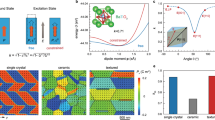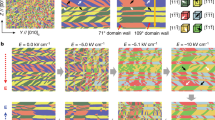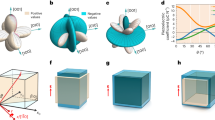Abstract
Piezoelectric materials, which convert mechanical to electrical energy (and vice versa), are crucial in medical imaging, telecommunication and ultrasonic devices1,2. A new generation of single-crystal materials3, such as Pb(Zn1/3Nb2/3)O3–PbTiO3 (PZN–PT) and Pb(Mg1/3Nb2/3)O3–PbTiO3 (PMN–PT), exhibit a piezoelectric effect that is ten times larger than conventional ceramics, and may revolutionize4 these applications. However, the mechanism underlying the ultrahigh performance of these new materials—and consequently the possibilities for further improvements—are not at present clear. Here we report a first-principles study of the ferroelectric perovskite, BaTiO3, which is similar5 to single-crystal PZN–PT but is a simpler system to analyse. We show that a large piezoelectric response can be driven by polarization rotation induced by an external electric field. Our computations suggest how to design materials with better performance, and may stimulate further interest in the fundamental theory of dielectric systems in finite electric fields.
This is a preview of subscription content, access via your institution
Access options
Subscribe to this journal
Receive 51 print issues and online access
$199.00 per year
only $3.90 per issue
Buy this article
- Purchase on Springer Link
- Instant access to full article PDF
Prices may be subject to local taxes which are calculated during checkout


Similar content being viewed by others
References
Lines, M. E. & Glass, A. M. Principles and applications of ferroelectrics and related materials (Clarendon, Oxford, 1979).
Uchino, K. Piezoelectric actuators and ultrasonic motors (Kluwer Academic, Boston, 1996).
Park, S. -E. & Shrout, T. R. Ultrahigh strain and piezoelectric behavior in relaxor based ferroelectric single crystal. J. Appl. Phys. 82, 1804–1811 ( 1997).
Service, R. F. Shape-changing crystals get shiftier. Science 275, 1878 (1997).
Park, S. -E. et al. Crystallographic engineering in high-performance piezoelectric crystals. J. Appl. Phys. (submitted).
Durbin, M. K., Jacobs, E. W., Hicks, J. C. & Park, S. -E. In situ x-ray diffraction study of an electric field induced phase transition in the single crystal relaxor ferroelectric, 92% Pb(Zn1/3Nb 2/3)O3-8%PbTiO3. Appl. Phys. Lett. 74, 2848–2850 ( 1999).
Garcia, A. & Vanderbilt, D. Electromechanical behavior of BaTiO3 from first-principles. Appl. Phys. Lett. 72, 2981–2983 (1998).
Cohen, R. E. Origin of ferroelectricity in oxide ferroelectrics and the difference in ferroelectric behavior of BaTiO3 and PbTiO3. Nature 358, 136–138 (1992).
Egami, T., Dmowski, W., Akbas, M. & Davies, P. K. in First-principles Calculations for Ferroelectrics: Fifth Williamsburg Workshop (ed. Cohen R. E.) 1–10 (AIP, Woodbury, New York, 1998).
Wei, S. H. & Krakauer, H. Local-density-functional calculation of the pressure-induced metallization BaSe and BaTe. Phys. Rev. Lett. 55, 1200–1203 ( 1985).
Singh, D. J. Planewaves, Pseudopotentials and the LAPW Method (Kluwer, Boston, 1994).
King-Smith, R. D. & Vanderbilt, D. Theory of polarization of crystalline solids. Phys. Rev. B 47, 1651–1654 (1993).
Resta, R. Macroscopic polarization in crystalline dielectrics: the geometric phase approach. Rev. Mod. Phys. 66, 899– 915 (1994).
Saghi-Szabo, G., Cohen, R. E. & Krakauer, H. First-principles study of piezoelectricity in PbTiO 3. Phys. Rev. Lett. 80, 4321– 4324 (1998).
Martin, R. M. & Ortiz, G. Functional theory of extended Coulomb systems. Phys. Rev. B 56, 1124– 1140 (1997).
Ghosez, Ph., Michenaud, J.-P. & Gonze, X. The physics of dynamical atomic charges: The case of ABO3 compounds. Phys. Rev. B 58, 6224–6239 (1998).
Mitsui, T. Ferroelectrics and Related Substances (eds K. H. Hellwege & O. Madelung) Landolt-Bornstein, New Series Group III, Vol. 16, Pt a (Springer, Berlin, 1981).
Zgonik, M. et al. Dielectric, elastic, piezoelectric, electro-optic, and elasto-optic tensors of BaTiO3 crystals. Phys. Rev. B 50, 5941–5949 (1994).
Acknowledgements
We thank H. Krakauer and D. Singh for sharing their LAPW codes and discussions; S.E. Park for sending us the experimental data in Fig. 1a and ref. 5; and D. Vanderbilt, S.E. Park, T. Shrout, W. Smith and K. Rabe for discussions. This work was supported by the Office of Naval Research. Computations were performed on the CRAY SV1 supported by the NSF and the Keck Foundation.
Author information
Authors and Affiliations
Corresponding author
Rights and permissions
About this article
Cite this article
Fu, H., Cohen, R. Polarization rotation mechanism for ultrahigh electromechanical response in single-crystal piezoelectrics. Nature 403, 281–283 (2000). https://doi.org/10.1038/35002022
Received:
Accepted:
Issue Date:
DOI: https://doi.org/10.1038/35002022
This article is cited by
-
Candidate ferroelectrics via ab initio high-throughput screening of polar materials
npj Computational Materials (2024)
-
Enhanced polarization retention and softening in [001]-oriented Pb(Mg1/3Nb2/3)-PbTiO3 single crystals through corona poling
Journal of the Korean Ceramic Society (2024)
-
Self-organization of ferroelectric domains induced by water and reinforced via ultrasonic vibration
Communications Materials (2023)
-
An interpretable machine learning strategy for pursuing high piezoelectric coefficients in (K0.5Na0.5)NbO3-based ceramics
npj Computational Materials (2023)
-
Emergence of high piezoelectricity from competing local polar order-disorder in relaxor ferroelectrics
Nature Communications (2023)
Comments
By submitting a comment you agree to abide by our Terms and Community Guidelines. If you find something abusive or that does not comply with our terms or guidelines please flag it as inappropriate.



